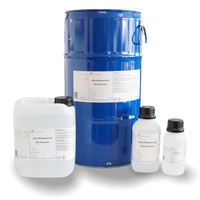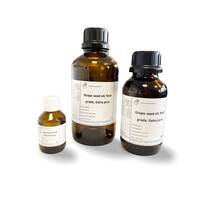You have no items in your shopping cart
Methanesulfonic acid 70%
- Buy 2 and save 5%
- Buy 6 and save 10%
Methanesulfonic acid, better known as MSA, is an organic sulfuric acid with the chemical formula CH₃SO₃H. It is a colorless liquid that is soluble in water and organic solvents. MSA is known for its strong acidic properties, similar to those of sulfuric acid, but it is considered milder and safer to use.
What is Methanesulfonic Acid used for?
- Catalyst in Organic Synthesis
Methanesulfonic acid is widely used as a catalyst in organic chemical reactions. Due to its strong acidity, it can accelerate reactions without the oxidative side effects often associated with other strong acids like sulfuric acid. This makes it ideal for applications such as:
- Esterification: MSA is often used to form esters from alcohols and acids.
- Polymerization: It is used in the polymerization of certain monomers into polymers.
- Pharmaceutical Industry
In the pharmaceutical industry, methanesulfonic acid plays a crucial role in the production of medicines. It is used in the:
- Synthesis of active pharmaceutical ingredients (APIs): MSA is an essential reagent in the synthesis of various drugs.
- Purification of compounds: Thanks to its solubility properties, MSA helps in the purification of chemical compounds.
- Electroplating Industry
Methanesulfonic acid is widely used in the electroplating industry due to its excellent conductivity and stability. It is applied in:
- Electrodeposition: The acid helps in the deposition of metals such as tin, lead, and others on various surfaces, which is crucial for the production of electronic components.
- Galvanizing: MSA ensures a smooth, even coating without unwanted side effects.
- Cleaning Agents
Methanesulfonic acid is used in various industrial and household cleaning agents due to its ability to remove stubborn stains and deposits without causing corrosive damage. Specific applications include:
- Descaling agents: Effective in removing lime and mineral deposits.
- Cleaning equipment: Used for cleaning industrial machines and equipment.
- Biodiesel Production
In biodiesel production, methanesulfonic acid is used as a catalyst in transesterification reactions, where vegetable oils or animal fats are converted into biodiesel and glycerin.
- Ionic Liquids
Methanesulfonic acid serves as a building block for the synthesis of ionic liquids, which are used in various applications, from catalysis to electrochemical processes.
- Water Treatment
In the water treatment sector, methanesulfonic acid is used to remove heavy metals and other contaminants from water.
- Other Chemical Industries
It is also used in various other chemical industries, such as the production of coatings, adhesives, and as an intermediate in the synthesis of other chemical compounds.
Safe Handling of Methanesulfonic Acid
- Personal Protective Equipment (PPE)
- Gloves: Wear acid-resistant gloves, such as those made of neoprene, nitrile, or PVC, to avoid skin contact.
- Protective clothing: Use a lab coat or acid-resistant apron to protect your body from splashes.
- Eye protection: Wear safety goggles or a face shield to protect your eyes from possible splashes.
- Respiratory protection: In case of inadequate ventilation or when working with large quantities, it is advisable to use a gas mask with an acid filter.
- Workspace and Ventilation
- Well-ventilated area: Work in a well-ventilated area, preferably under a fume hood, to minimize exposure to vapors.
- Emergency shower and eyewash station: Ensure that an emergency shower and eyewash station are nearby in case of an accident.
- Handling and Storage of Methanesulfonic Acid
- Transport: Always use chemically resistant containers to transport methanesulfonic acid.
- Storage: Store methanesulfonic acid in a well-ventilated area, away from direct sunlight and heat sources. Use acid-resistant materials for storage containers.
- Labeling: Ensure all containers are clearly labeled with the correct hazard symbols and information about the contents.
- Procedures for Use
- Add slowly: Always add methanesulfonic acid slowly to water or other solvents to prevent exothermic reactions. Never add water to the acid.
- Avoid metals: Avoid contact with metals, as methanesulfonic acid can be corrosive to many metals.
- Mixing and stirring: Use glass or acid-resistant plastic stirrers to mix the acid.
- Emergency Procedures
- Skin contact: Rinse immediately with plenty of water for at least 15 minutes. Remove contaminated clothing and seek medical attention.
- Eye contact: Rinse eyes immediately with water for at least 15 minutes and seek immediate medical attention.
- Inhalation: Move the person to a well-ventilated area or outdoors. Seek medical attention if symptoms occur.
- Ingestion: Do not induce vomiting. Rinse the mouth with water and seek immediate medical attention.
- Waste Disposal
- Neutralization: Neutralize methanesulfonic acid residues with an appropriate basic solution, such as sodium bicarbonate, before disposal.
- Regulations: Follow local regulations for the disposal of chemical waste. Use certified waste disposal companies if necessary.
Technical Data:
- MSA, Methanesulfonic Acid
- Empirical Formula: CH₄O₃S
- Molar Mass (M): 96.10 g/mol
- Density (D): 1.35 g/cm³
- Boiling Point (bp): 167 °C
- Flash Point (flp): 189 °C
- Melting Point (mp): -54 °C
- ADR: 8 III
- WGK: 1
- CAS No.: 75-75-2
- EG No.: 200-898-6
- UN No.: 2586
Hazard Statements
- H290: May be corrosive to metals.
- H302+H312: Harmful if swallowed or in contact with skin.
- H314: Causes severe skin burns and eye damage.
- H335: May cause respiratory irritation.
Precautionary Statements
-
Precautionary Statements - Prevention
- P280: Wear protective gloves/protective clothing/eye protection/face protection.
-
Precautionary Statements - Response
- P303+P361+P353: IF ON SKIN (or hair): Take off immediately all contaminated clothing. Rinse skin with water [or shower].
- P304+P340: IF INHALED: Remove person to fresh air and keep comfortable for breathing.
- P305+P351+P338: IF IN EYES: Rinse cautiously with water for several minutes. Remove contact lenses, if present and easy to do. Continue rinsing.
- P312: Call a POISON CENTER/doctor if you feel unwell.






